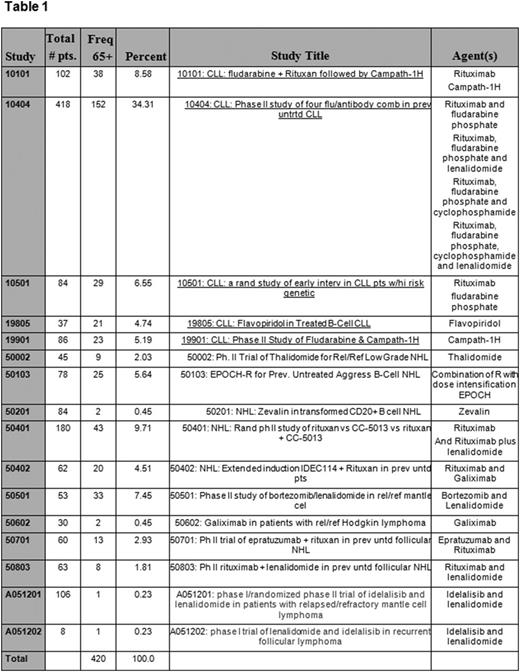Abstract
Background: Contemporary approaches to non-Hodgkin lymphoma (NHL) and chronic lymphocytic leukemia (CLL) incorporate chemo-immunotherapy, biologic combinations, and immune modulating agents; toxicities in elderly pts (³65 years) receiving these therapies are not well studied. Further, clinical and biologic factors predicting these toxicities in pts receiving biologic therapy remain undefined.
Methods: We reviewed data on NHL and/or CLL pts treated prospectively on 14 studies by the Alliance for Clinical Trials in Oncology from 2004-2014 (Table 1). Toxicity was assessed per the NCI CTCAE at the time of trial enrollment, and the probabilities of experiencing grade 3 and grade 4 hematologic (hem) and non-hematologic (non-hem) toxicities were modeled as a function of age (³65 years vs. < 65), time on study, treatment (biologics only vs. biologic + chemotherapy), gender, race, LDH, performance status (PS), stage, and an age-by-treatment interaction using logistic regression.
Results: A total of 1199 pts (409 age ³ 65; 790 age < 65; 736=CLL and 463=NHL) were included. Among these patients, 493 received only biologic therapy (166 age ³ 65; 327 age < 65; 104 CLL; 389 NHL), and 706 received biologic + chemotherapy (243 age ³ 65; 463 age < 65; 632 CLL; 74 NHL). Among CLL pts (259 pts ³ 65), the effect of age on the probability of experiencing a grade 3 heme toxicity differed by treatment type (age-by-treatment interaction p = 0.047). Specifically, the adjusted odds ratio (OR) (age ³ 65 vs. < 65) for pts receiving only biologic therapy was 3.075 (95% CI: 1,15-8.25), and that for pts receiving biologic + chemotherapy was 1.044 (95% CI: 0.69 - 1.57). Similar results were seen in CLL pts for grade 4 heme toxicities (age-by-treatment interaction p = 0.033; biologic OR 6.937, 95% CI: 1.76-27.35; biologic + chemo OR 1.484, 95% CI: 1.04-2.13). No such interactions were found in CLL pts for grade 3 and 4 non-hem toxicities; however, older pts had significantly higher odds of experiencing a grade 3 non-hem toxicity than younger pts (adjusted OR 1.40; p = 0.047; 95% CI: 1.004-1.96). No age group differences were found in CLL pts for grade 4 non-hem toxicity. Similar analyses were performed for NHL pts (150 pts ³ 65), but no significant age group differences were found.
Among CLL pts, women had significantly higher odds of experiencing a grade 3 heme toxicity than men (OR 2.01; p = 0.0007); no difference in grade 3 non-hem or any grade 4 toxicity was noted. Non-Caucasian CLL pts had higher odds of experiencing a grade 4 non-hem toxicity than Caucasians (OR 2.892; p = 0.0029), but no other toxicity differences were found. Worse PS was associated with increased toxicities (OR 1.871; p = 0.0009: grade 3 heme; OR 1.647; p = 0.0025: grade 3 non-hem; OR 1.410; p = 0.0448: grade 4 heme, and OR 1.931; p = 0.0252: grade 4 non-hem). CLL pts with advanced stage disease had higher odds of experiencing a heme toxicity (grade 3: OR 1.95; p = 0.0007, grade 4: OR 1.451; p = 0.0329), but no stage associations were found for non-hem toxicities.
Among NHL pts, men had significantly higher odds of experiencing a grade 4 hematologic toxicity than women (OR 4.351; p = 0.0169), but no other toxicity differences were found. An increase in LDH was associated with significantly higher odds of experiencing grade 3 non-hem and grade 4 heme toxicities (grade 3 non-heme: OR 1.633; p = 0.021, grade 4 heme: OR 2.039, p = 0.0182), but no such effect was found for grade 3 heme or grade 4 non-hem. Worse PS was associated with higher odds of experiencing grade 3 toxicities (heme: OR 2.025; p = 0.0344, non-hem: OR 2.458; p = 0.0013), but no such differences were found for grade 4 toxicities. No significant stage or race effects were found in NHL patients.
Conclusion: In pts ³65 years who have CLL or NHL, we identified several clinical and disease-related factors as potential predictors of developing grade 3 and/or 4 heme and non-hem toxicities (Table 2). A prognostic model is being constructed to predict toxicities in these under-studied pts to guide management and monitoring. Further, the impact of these toxicities on outcomes is being analyzed and will be presented at the meeting.
Hurria:Celgene: Other: Research; Optum Health Care SOlutions: Consultancy, Other: Conference panel, research; Boehringer Ingelheim Pharmaceuticals: Consultancy; Sanofi: Consultancy; Carevive: Consultancy; Novartis: Other: Research; GTx, Inc: Consultancy. Bartlett:Gilead: Consultancy. Cheson:Gilead: Research Funding; Acerta: Membership on an entity's Board of Directors or advisory committees, Research Funding; Pharmacyclics: Membership on an entity's Board of Directors or advisory committees, Research Funding. Nabhan:Infinity: Consultancy; Abbvie: Consultancy; Cardinal Health: Consultancy; Seattle Genetics: Research Funding; Genentech: Consultancy, Research Funding; Astellas: Research Funding; Celgene Corporation: Consultancy, Research Funding.
Author notes
Asterisk with author names denotes non-ASH members.



This feature is available to Subscribers Only
Sign In or Create an Account Close Modal